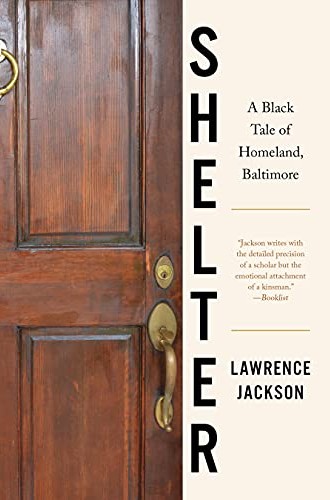Lawrence Jackson’s memoir tells a story of location shaped by race
Baltimore—from Frederick Douglass to Freddie Gray—informs his whole journey.
Shelter addresses the meaning of an address. Lawrence Jackson tells the story of moving back to Baltimore with his sons after getting a teaching job at Johns Hopkins University. Settled into his new neighborhood, he peels back the layers of what place means and explores ideas of how home and location contribute to a sense of belonging and legacy. Throughout the memoir’s pages, which proceed through the seasons of the church year, Jackson untangles intertwining stories of self, family, community, country, identity, theology, parenting, and the history of race in America.
Baltimore—from Frederick Douglass to Freddie Gray—informs Jackson’s journey, from a childhood in Northwest Baltimore to a new home in Homeland (a neighborhood founded to be exclusive to White residents) and a job at Johns Hopkins, the university with which the city has a love-hate relationship. As Shelter tells the story of Baltimore, we hear what it is like to cross unspoken boundaries, to receive accusations of betrayal, and to lean into the future with hope and something to give the next generation. Place, neighborhood, and city offer a wonderful setting for Jackson to tell the story of his own life through the framework of what it is to be Black in America today.
Jackson sets forth his experiences with honesty and insight. These stories are sometimes heartwarming and other times heartbreaking. He tells of a trip to the Eastern Shore, highlighting the warmth of connection and storytelling he feels in an antique shop, warmth that is immediately followed by the coolness of a restaurant server. He shares many tales of the labor required to tend to his new lawn, augmented by his observations of hired Latino landscapers at work in neighboring yards while trucks occasionally drive by with Confederate flags or Trump bumper stickers. He talks about being treated as “other” in the Black neighborhood of his childhood until he has the opportunity to tell his story and solidify his credibility.
Shelter is written in sharply beautiful, descriptive prose. Jackson’s love of language is woven into each sentence, alongside his understanding of the current moment as informed by the depth of all that came before. Noting that his childhood church features a White Jesus “in the form of an imposing anthropomorphic tiled mosaic behind the altar depicting the ascension of Jesus the Light,” Jackson adds:
I have long been fascinated and repulsed by the mosaic, and I know that it must be an object of professional curiosity to those more incisive and learned than I. Why does Saxon Jesus unnerve me and not Saxon tree worship at Christmas or egg-and-hare Saxon fertility rites for the goddess Eostre?
At another point, he wryly explains that “working to appear mild-mannered and hiding petulance are my gifts to the world.”
Jackson’s extensive historical research is clear as each city block in his narrative comes alive with story. I found myself dusting off my dictionary a time or two as he introduced me to just the right word for what he was describing. Once I became acclimated to the rhythm of his writing, I found myself grateful for the care he takes with language, the dry wit within it, and the real beauty in his prose.
I am a transplant to Baltimore who has served communities in the first-ring suburbs of Lansdowne and Dundalk. Jackson’s work of understanding community within the history of race and place in Baltimore helps me see the place I have called home for 16 years in a new way. However, the work that Shelter does, while firmly rooted in its location, is not unique to Baltimore. It challenges each of us to look deeply at the place we call home and learn the stories of streets, boundaries, statues, parks, and music. It calls us to perceive the spoken and unspoken history of our surroundings.
Shelter is a story about how location—not just Baltimore, but the United States—is shaped by race. In the wake of public murders like the shooting of Ahmaud Arbery, who was killed because he was a Black man going for a jog in his “White” neighborhood, books like this one are particularly important. Jackson allows readers to walk in his shoes, to ride the Hopkins bus, to hear the music, and to turn over the earth in his front yard—and in so doing, to experience through his eyes what it is to find home, belonging, meaning, and legacy. As he graciously invites readers into his life, his hopes for his children, and the wisdom of those who have gone before, he helps us to understand where we have been and where we could go.





